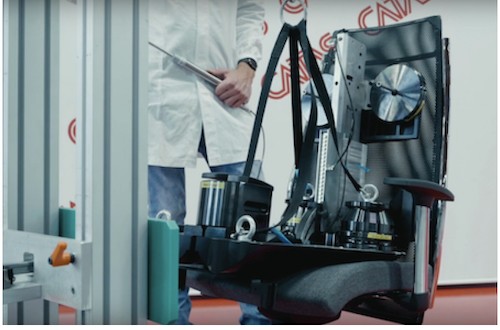
In these days
an international research project has been officially launched, about the methods for measuring the dimensions of office chairs, promoted by the working group 3 “Office furniture” of the Technical Committee of European standardization CEN/TC 207 “Furniture”.
A dozen European laboratories are involved in this study which technically is called a "collaborative (non-evaluative) interlaboratory circuit". Four office chairs, representative of the production of as many international companies, will circulate in sequence among the participating laboratories so that everyone can measure their dimensions using their own technicians and equipment and in their own laboratory conditions. What will be kept constant will be precisely the measurement method, which is the new one introduced by the last revision of EN 1335-1, currently at formal vote (it will be published in 2020). This European standard is based on the international standard ISO 24496: 2017 Office furniture - Office chairs - Methods for the determination of dimensions which defines, among other things, the CMD (Chair Measuring Device), which is a special equipment for measuring chairs, and the measuring methods themselves, based on its use.
When all the laboratories have completed the measurements, the results will be statistically analyzed to determine the uncertainty of measurement that can reasonably be associated with this method. The data obtained will be included in the standard and will constitute the reference value which each laboratory will have to comply with in order to perform the test under accreditation. Therefore the final objective is
to homogenize the measurement uncertainty of the various laboratories, to protect the producers who can then choose among laboratories with the guarantee that, if accredited, they will all perform the measurements with uncertainty less than or equal to that reported in the standard.
Usually interlaboratory circuits or “round robin tests” are of the "evaluative" type, i.e. they have the objective of measuring the performance of the participating laboratories in the execution of a test method whose repeatability and reproducibility is already known. In this case instead, the circuit has the purpose of determining the measurement uncertainty associated with the method itself; for this reason it is defined as "collaborative" and the participants were chosen among the laboratories considered to be the most expert in this field.
A similar study had already been conducted in Europe in 2010, relating to the previous version of EN 1335-1 and coordinated by Catas. A second study concerning ISO 24496 was conducted internationally, and had jointly analyzed the results of two interlaboratory circuits, one carried out in North America and organized by the BIFMA (Business Institutional Furniture Manufacturers Association) and another one carried out in Europe, organized by CEN/TC 207 and coordinated by Catas.
Also for this new study
Catas has a coordinating role, in collaboration with
Fira International, the British reference body for the furnishing sector, and with
EPT, a network of professionals working in different organizations who use Statistics to give robust answers to complex problems. EPT was founded by Quotasette srl and with the web portal
www.proficiencyproblemsolving.com manages collaborative studies in the Chemical, Mechanical, Environmental and Food fields.
For info:Annamaria Franz
+39 0432 747241
franz@catas.com

 In these days an international research project has been officially launched, about the methods for measuring the dimensions of office chairs, promoted by the working group 3 “Office furniture” of the Technical Committee of European standardization CEN/TC 207 “Furniture”.
In these days an international research project has been officially launched, about the methods for measuring the dimensions of office chairs, promoted by the working group 3 “Office furniture” of the Technical Committee of European standardization CEN/TC 207 “Furniture”.